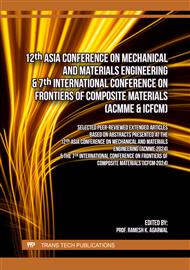[1]
Esmaeili-Rad, M. R., et al. "Optical properties of nanocrystalline silicon deposited by PECVD." Journal of Materials Science: Materials in Electronics 18 (2007): 405-409.
DOI: 10.1007/s10854-007-9230-8
Google Scholar
[2]
King, S. W., et al. "Mass and bond density measurements for PECVD a-SiCx: H thin films using Fourier transform-infrared spectroscopy." Journal of non-crystalline solids 357.21 (2011): 3602-3615.
DOI: 10.1016/j.jnoncrysol.2011.07.004
Google Scholar
[3]
Flewitt, A. J., et al. "Characterization of defect removal in hydrogenated and deuterated amorphous silicon thin film transistors." Journal of non-crystalline solids 352.9-20 (2006): 1700-1703.
DOI: 10.1016/j.jnoncrysol.2005.12.025
Google Scholar
[4]
Ganji, Jabbar, Abdolnabi Kosarian, and Hooman Kaabi. "Mathematical Evaluation of a-Si: H Film Formation in rf-PECVD Systems." Silicon 12.3 (2020): 723-734.
DOI: 10.1007/s12633-019-00167-9
Google Scholar
[5]
Jafari, Sahar, et al. "Occurrence of sharp hydrogen effusion peaks of hydrogenated amorphous silicon film and its connection to void structures." physica status solidi (b) 257.9 (2020): 2000097.
DOI: 10.1002/pssb.202000097
Google Scholar
[6]
Vivian E. Ferry, et al."Optimized Spatial Correlations for Broadband Light Trapping Nanopatterns in High Efficiency Ultrathin Film a-Si:H Solar Cells."Nano Letters 11 (2011): 4239-4245.
DOI: 10.1021/nl202226r
Google Scholar
[7]
Steffens, Jonathan, et al. "Replacing NRA by fast GD-OES measurements as input to a model based prediction of hydrogen diffusion in a-Si." Energy Procedia 124 (2017): 180-187.
DOI: 10.1016/j.egypro.2017.09.315
Google Scholar
[8]
Jafari, Sahar, et al. "Occurrence of sharp hydrogen effusion peaks of hydrogenated amorphous silicon film and its connection to void structures." physica status solidi (b) 257.9 (2020): 2000097.
DOI: 10.1002/pssb.202000097
Google Scholar
[9]
Liao, N. M., et al. "Raman study of a-Si: H films deposited by PECVD at various silane temperatures before glow-discharge." Applied Physics A 91 (2008): 349-352.
DOI: 10.1007/s00339-008-4413-6
Google Scholar
[10]
Mishima, Y., and T. Yagishita. "Investigation of the bubble formation mechanism in a‐Si: H films by Fourier‐transform infrared microspectroscopy." Journal of applied physics 64.8 (1988): 3972-3974.
DOI: 10.1063/1.341355
Google Scholar
[11]
Martins, R., et al. "Role of the gas temperature and power to gas flow ratio on powder and voids formation in films grown by PECVD technique." Vacuum 56.1 (2000): 25-30.
DOI: 10.1016/s0042-207x(99)00158-x
Google Scholar
[12]
Bhandarkar, Upendra, Uwe Kortshagen, and Steven L. Girshick. "Numerical study of the effect of gas temperature on the time for onset of particle nucleation in argon–silane low-pressure plasmas." Journal of Physics D: Applied Physics 36.12 (2003): 1399.
DOI: 10.1088/0022-3727/36/12/307
Google Scholar
[13]
Boufendi, L., et al. "Detection of particles of less than 5 nm in diameter formed in an argon–silane capacitively coupled radio-frequency discharge." Applied Physics Letters 79.26 (2001): 4301-4303.
DOI: 10.1063/1.1425431
Google Scholar
[14]
Shanks, H. R., and L. Ley. "Formation of pin holes in hydrogenated amorphous silicon at high temperatures and the yield strength of a‐Si: H." Journal of Applied Physics 52.2 (1981): 811-813.
DOI: 10.1063/1.328767
Google Scholar
[15]
Beyer, Wolfhard. "Hydrogen incorporation, stability, and release effects in thin film silicon." physical status solidi (a) 213.7 (2016): 1661-1674.
DOI: 10.1002/pssa.201532976
Google Scholar
[16]
Gu, Zhen, et al. "Understanding surface adhesion in nature: a peeling model." Advanced Science 3.7 (2016): 1500327.
Google Scholar
[17]
Melskens, Jimmy, et al. "Migration of open volume deficiencies in hydrogenated amorphous silicon during annealing." IEEE Journal of Photovoltaics 7.2 (2017): 421-429.
DOI: 10.1109/jphotov.2016.2646421
Google Scholar



